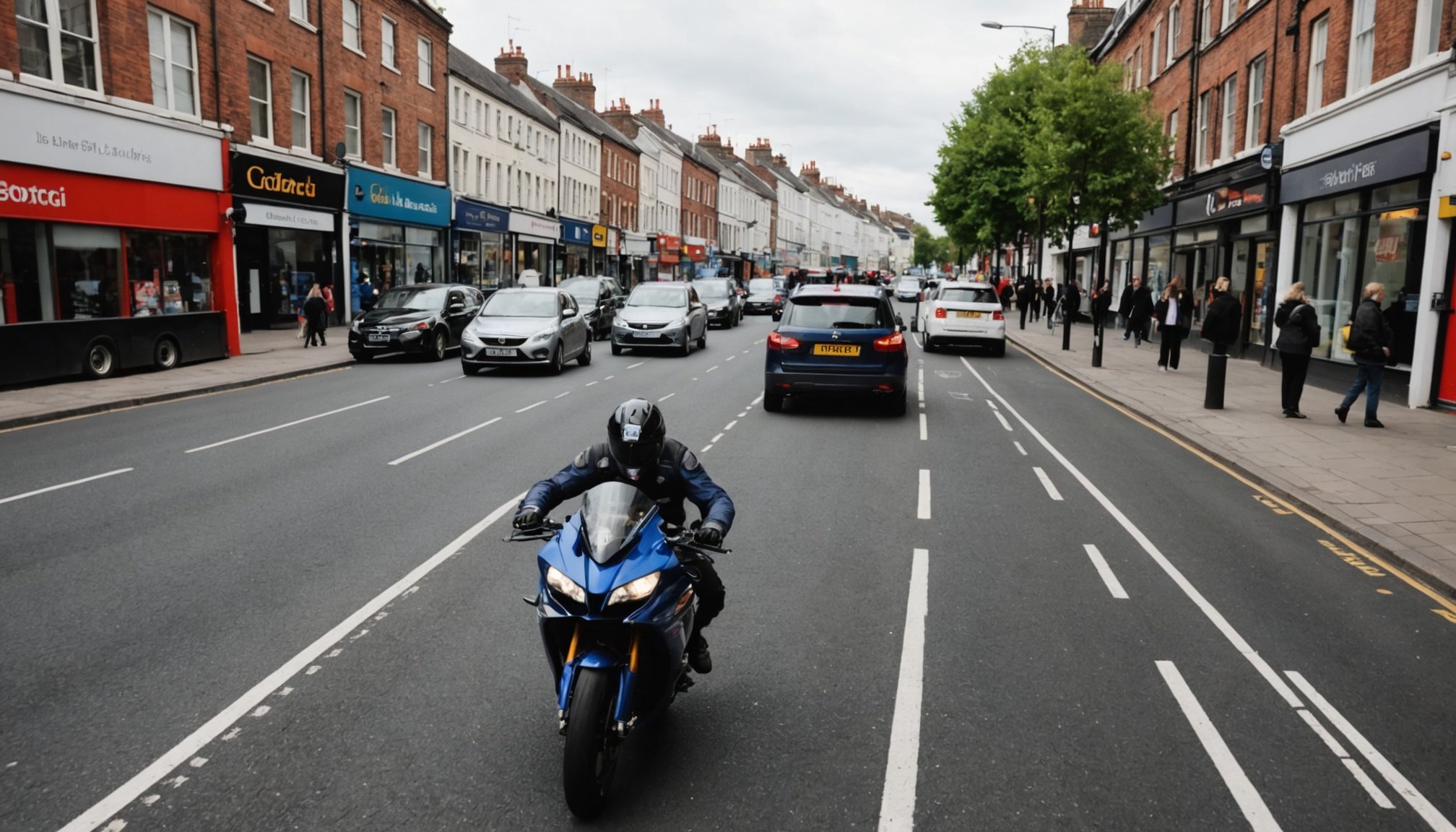Overview of Bus Lane Regulations in the UK
Bus lanes in the UK are specially designated lanes on roads to prioritise buses, often facilitating quicker journeys and reducing traffic congestion. UK bus lane laws ensure that these lanes serve their primary purpose by regulating vehicle use strictly. Generally, only buses, cyclists, and taxis can use these lanes during their operational hours.
Motorcycle regulations in bus lanes vary significantly across different localities. While some areas permit motorcycles to use bus lanes, others may restrict or prohibit their access. Therefore, understanding local variations is crucial for riders. Road signs, which display operating hours and permissible vehicles, are essential for compliance.
Additional reading : Unveiling how different sport bike tires influence handling in the uk”s wet weather
Local councils may implement unique rules based on traffic conditions and urban planning needs. This means motorcycle riders must remain vigilant and informed about the specific regulations in the areas they intend to travel. The lack of standardisation across the UK can lead to confusion, but it is an opportunity for locals and commuters alike to involve themselves in community discussions, advocating for clarity and consistency in bus lane regulations. This dynamic regulatory landscape underscores the importance of engaging with local transport authorities.
Legal Guidelines for Riding Sport Bikes in Bus Lanes
Navigating the legal guidelines for riding sport bikes in bus lanes requires understanding specific regulations. UK bus lane laws generally restrict vehicle entry to certain categories. However, some local councils allow motorcycles, including sport bikes, to share these lanes.
Also to read : Unlock superior traction on uk’s bumpy roads: a complete guide to optimizing your sport bike”s rear suspension
Sport bikes, while mechanically similar to other motorcycles, may face different restrictions based on locality-specific rules. These guidelines often stem from the vehicle’s size, speed, and impact on traffic flow. Riders must pay close attention to road signage and markings, which clearly indicate bus lane permissions and operating hours.
Compliance with these regulations is crucial to avoid penalties. Differences between motorcycle classes and their rights within bus lanes point toward local council autonomy in rule-making. Riders should be vigilant, checking local transportation authorities for specific rules regarding sport bikes.
Authorities provide clear markings and signs to guide riders. Being aware of these signs can ensure compliance and avoid unnecessary fines. By following legal guidelines, riders can safely and legally use bus lanes, benefiting from reduced congestion and faster commutes. Riders are encouraged to engage with local regulations to advocate for any needed amendments.
Exemptions and Exceptions to Bus Lane Laws
Understanding bus lane exemptions is vital for riders navigating UK roads. While bus lanes primarily serve public transport, specific exemptions exist. Emergency vehicles, such as ambulances and police cars, are generally exempt to ensure swift response times. Additionally, public transport services may operate under separate rules, reflecting their necessity in reducing congestion.
Motorcycles often embody a unique category within bus lane exemptions, although these are more restricted. Local councils wield authority to grant exceptions, adapting to regional traffic conditions. This means that riders might encounter varying rules about which motorcycle types can use bus lanes, notably impacting regions with high two-wheeler traffic.
Aside from public transport and emergency services, certain councils may permit other vehicles based on environmental policies or congestion troubleshooting. Engaging with local authorities can provide clarity. Being aware of these notable exceptions aids riders in lawful and efficient commuting, avoiding penalties associated with bus lane misuse.
Motorcyclists are urged to verify regulations specific to their planned routes. This proactive step ensures compliance amidst evolving local council policies. By recognising these nuances, riders embrace responsible road-sharing, contributing to overall traffic efficacy.
Penalties for Violating Bus Lane Regulations
Navigating bus lanes in the UK involves understanding the bus lane penalties that accompany violations. A common consequence of improper use includes receiving fines. These penalties are often issued through automated systems, such as cameras that detect unauthorised vehicles in bus lanes. Fines for motorcycles, when caught, could range substantially depending on local council bylaws and severity.
When a rider receives a penalty, they are usually given instructions on how to address it. Contesting fines is possible but involves providing evidence or an acceptable reason for the alleged violation. This process often requires interaction with the relevant local council and possibly attending a hearing.
Repeated violations can lead to increased scrutiny on motorcycle riders, impacting not just their finances but possibly influencing their insurance premiums and driving records. Accumulating fines may also necessitate mandatory educational programs or stricter enforcement measures.
It’s paramount for riders to engage in good practices, staying informed about the rules and keeping abreast of enforcement trends. Understanding the implications of bus lane violations ensures that riders can avoid them, thereby fostering safer and more efficient use of public roadways.
Best Practices for Riding in Bus Lanes
Adopting motorcycle best practices is essential for a safe and legal experience in bus lanes. Understanding the rules and respecting other road users contributes to a smoother ride. One key tip is to always check road signs and markings, as these will indicate the lanes motorcycles can use and the specific times of day when access is permitted. Thus, vigilance is a prime factor in adhering to regulations.
Awareness of bus lane dynamics involves recognising the rights of buses, cyclists, and other permitted vehicles. Constant interaction with other road users requires caution and respect to prevent incidents. Utilizing available technology and apps designed for navigation can significantly aid in staying updated with real-time traffic changes and avoiding restricted lanes inadvertently.
To enhance safety, riders can benefit from apps that offer live navigation updates. These tools help in assessing traffic conditions and understanding current road-sharing dynamics. Moreover, riders should keep abreast of any potential legal amendments communicated through local transport authorities, ensuring compliance and contributing to a more streamlined traffic environment. Employing these practices allows motorcyclists to navigate bus lanes effectively, fostering a cooperative atmosphere on the road.
Case Studies and Real-Life Examples
Exploring case studies and real-life scenarios involving motorcycles in bus lanes offers valuable insights into the practical enforcement of bus lane laws. These examples highlight challenges and solutions riders face and inform regulatory updates.
One notable case involved a motorcyclist in London contesting a fine, arguing that unclear signage led to their use of a bus lane. The adjudication focused on the clarity of road markings and whether they adequately informed riders. This case underscored the need for improved signage to prevent inadvertent violations.
Another exemplar is a study from Manchester, where targeted enforcement of bus lane infractions helped refine regulations. This particularly highlighted the importance of considering traffic patterns and community feedback in establishing realistic and fair legal stipulations.
These cases show us outcomes that often shape current motorcycle regulations. Successful appeals generally emphasize thorough evidence, such as photographic proof or eyewitness accounts, illustrating misunderstandings or genuine mistakes rather than deliberate negligence.
Through these real-life examples, riders can better appreciate the complexities of bus lane laws and the importance of adhering to established guidelines. Engaging with these narratives encourages awareness, advocacy, and future improvements in legislative frameworks.
Resources and Further Reading
For motorcyclists seeking to understand motorcycle law resources and UK bus lane regulations, several helpful tools are available. Engaging with official websites like the UK Department for Transport provides comprehensive insights into general traffic laws and specific local transport authority guidelines. These websites often feature FAQs, downloadable guides, and contact details for further inquiries, ensuring riders remain well-informed.
Exploring recommended literature such as the Highway Code can deepen one’s grasp of UK transport authority rules. This publication includes detailed sections on motorcycle law resources, crucial for navigating bus lanes legally. Readers should leverage these resources to avoid legal pitfalls and enhance their road safety knowledge.
Local authorities often have their own webpages offering specific regulations pertinent to their area. These contain relevant updates on bus lane permissions and motorcycle law resources, aiding riders in adhering to local requirements. Engaging directly with their support lines can clarify any doubt riders may have.
By utilising these resources, motorcyclists can make informed decisions, advocate for necessary policy amendments, and contribute to their communities’ safer traffic conditions. Embracing this information strengthens their understanding and encourages responsible riding practices.
















